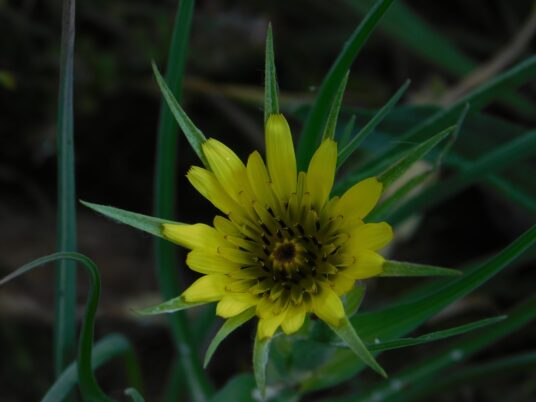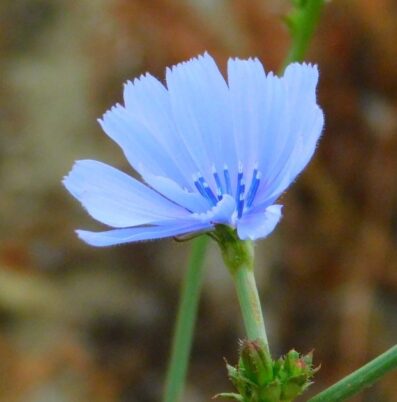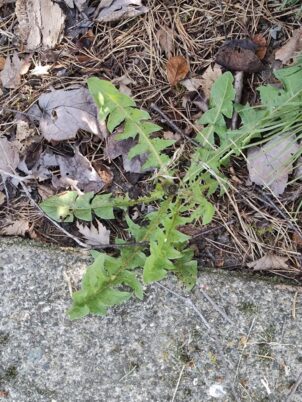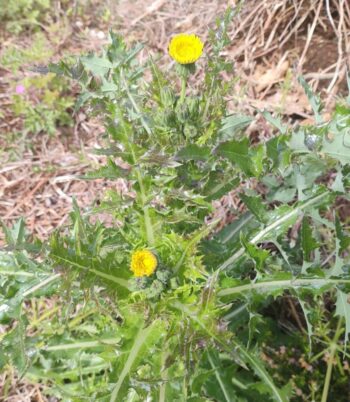Dandelion Time
by Marcia Wilson
Dandelion Time:

Spring means dandelions…and not everyone is pleased. This culinary companion from Eurasia has been on the table for thousands of years. Taraxacum officinale is an odd example of “beauty in the eye of the beholder” because it has as many friends as enemies. Taraxacum is believed to come from the Arabic tarakhshagog for “bitter” but may also be related to a Greek word that means “disturbed.”
The leaves pretend to be sharp; it is mis-identified as much as it is identified. It is sold for high prices in gourmet stores, but eradicated by the same people who eat them. They are cultivated for medicinal uses yet a deadly allergen for those sensitive to asters. They are nutritious, but bitter. They are soft herbs that can grow in the harshest of soil, their seemingly weak stalks and leaves capable of bursting out of asphalt and concrete. Countless cookbooks are sold in their honor but so are their herbicides. They are as contradictory and indomitable as a spring storm.
Small wonder, then, that an entire field of study exists in its honor: Taraxacology. Its specific botanists are taraxacologists. If this sounds like a lot of fuss for the bane of your yard’s existence, remember that dandelions are complex creatures, with thousands of microspecies.
Dandelion paradigm:
Most North Americans are surprised to learn we have our own native Taraxacum cetophorum, the Horned Dandelion. The Burke Herbarium posted photos from Pierce County in its online records and David Douglas, the namesake to the Douglas Fir, had a few lively words to say about it: “Taraxacum ceratophorum is the most widespread native dandelion in North America, ranging from the low Arctic and boreal zone to the western Cordilleras, in the montane and alpine zones. This complex has been subdivided into many microspecies in North America, most of which appear unworthy of recognition.”
This stubborn little fellow thrives above the treeline, where conditions are typically cold and scanty of soil. All Taraxacum share the same edible and medicinal properties and quickly hybridize with each other.
Dandelion Crimes:
Global sales on weedkillers are projected to reach ~$47 billion. Not every weedkiller will kill dandelions, but the market targets an appealing package where consumers choose to save money and employ broad herbicides against multiple species as opposed to specifics. Consumers are advised to look closely at labels for “broadleaf weeds”
Dandelion’s worst trick is against civic engineering. They break through parking lots, sidewalks, paved roads, hardpack and stone. Go here for a full breakdown on why this war will never be won.

Dandelion Good Times:
Dandelion greens are absolutely delicious to the fans, and the global market is extremely healthy with a projected $90 million in sales by 2030.
Dandelion Whine:
Even uninvited, the plant follows humans around. The tiny, barbed seeds catch on the lightest winds and travel as far as 100km, the length of 1000 Soccer fields. Studying this unique “parachute” of fluff attached to the long, torpedo-shaped seed has led to advances in drone technology. Seeds are technically “edible”—or it won’t kill you if you eat it—but humans are better off setting the table with dandelion-root coffee, pastries and fritters of the yellow flowers, and a meal of the leaves. The leaves must be picked as young as possible, preferably from a shady plot. From there they are boiled, then fried in butter or bacon grease. While it sounds like a lot of work, it was free food.
Dandelion Rhymes, or, not a dandelion.

Dandelions are arguably the most confused weed on campus, even among Envi-Sci students. Here are some of the biggest fakers:
- Salsify: Another non-native, this was brought over for its edible roots by Basque settlers, and occasional fad-foodies.
- Chicory: Also called blue dandelion, its root is also edible and its radicchio form is a familiar vegetable.
- Hawkweeds: Low in food value for native and non-native pollinators alike, it almost makes up for it by its striking yellow blooms. The toothy leaves hang tight, as if stapled to the ground. This and its smaller size are the fastest way to ID Hawkweed from Dandelion. Members of the group are Hawkweed, Mouse-Ear Hawkweed, Orange Hawkweed, Common Catsear, Yellow Devil Hawkweed, Rush Skeletonweed,
- Hawkweeds are all on the Bad Weed List for Pierce County and Washington State.
- Sow Thistle: This thistle is enjoyed as a spring green by foraging foodies since it is less bitter than dandelions of the same size. It is still a lot of work.
- Perennial Sowthistle. A Lilliputian weed, this mighty mite can show up right under a gardener’s nose.
-

Photo Marcia Wilson. Star Thistle by Building 16 - Yellow Star Thistle: a surprise when it showed up behind Building 16—ironically where the Env Sci classes are held.
Dandelion glime:

Why “dandelion”? The name comes from the French Dent-de-lion, or lion’s tooth because of the shape of the leaves. This mouthful is a lot more pleasant than its other common name, “wet the bed”—this is a powerful diuretic!
Dandelion Sublime
Remember: Dandelions show up FIRST. They beat all the spring emergent as soon as they can, with sow thistle and salsify following, and Hawkweed last of all in the drier months of summer. Which of them brings the most to the table, however, is up to personal taste. Besides the culinary value, they have revolutionized technological breakthroughs in drone technology, latex and automotive tire design, red dye, and more discoveries are in progress. We would be well advised to get to know this difficult neighbor.
